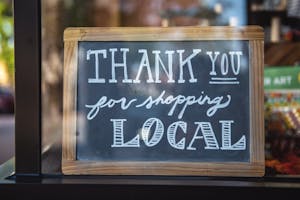- 60 minutes
- Digital Marketing
- Local Strategies
- Social Media
All Skill Levels
Get a behind-the-scenes-look into FareHarbor's 2024 season

Creating a loyal, local clientele base is an important part of a well-rounded business strategy. Once you are ready to grab a slice of the metaphorical local pie, you’ll need to put together a local marketing strategy.
Many of the marketing tools you already rely on to promote your tours, activities, and attractions—such as email, social media, and more—still apply when reaching locals, with a modified approach and message.
A local booker does not have to be limited to someone in your immediate city or town. Those travelers who can participate in day or weekend trips are an ideal target demographic. They are close enough to drive or take the train in for a visit without having to book accommodation or pay for other common trip-related expenses. A real win-win!
Appealing to local bookers transcends just creating additional marketing touch points to drive bookings. It also requires finding ways to stimulate and engage those within your community. Staying involved in your community allows you to develop trust and loyalty organically.
Network with other business owners in your area, join your local chamber of commerce, attend local events, and consider sponsoring local charities and causes.
 Pro-tip: Think about what you love most about the community you live in and the kinds of things that would motivate you to support another local business. Use this as your guiding light when crafting your own local messaging and identifying opportunities.
Pro-tip: Think about what you love most about the community you live in and the kinds of things that would motivate you to support another local business. Use this as your guiding light when crafting your own local messaging and identifying opportunities.
From a technical standpoint, working on local SEO is the first step to building your local marketing strategy because it increases your online visibility. Search engines understand that searchers want results that fit their query as it relates to three main facets: relevance, proximity, and prominence.
 Google Business Profile
Google Business ProfileYou can improve your business’s local ranking by optimizing your Google Business Profile. Google Business Profile is a business listing that displays important information about your company like contact information, location, hours of operation, and business category. Including full and accurate business information will help your business show up in the Local Map Pack in Google results.
 Review Management
Review ManagementWhen appealing to the local booker, one of the most important areas to focus on is review management, whether centered around existing reviews or new submissions. With 90% of consumers looking for a review before they visit a business (Bright Local), you can’t afford to fall behind when it comes to responding to reviews.
 Business Website
Business WebsiteIt’s also essential to optimize your website for mobile because a considerable percentage of local traffic comes from mobile devices. You can check the traffic sources and percentages for your website in Google Analytics. When optimizing your website for mobile, consider the following.
With the capability for increased personalization, email marketing still tends to be one of the highest converting and ROI-yielding marketing tactics. And what’s more personal than emailing those in your own community?
Use email marketing to keep customers up to date on what’s happening at your business. Promote things like the anniversary of your business, a new activity, or other special holidays. Consider offering a discount to those in your area if they bring a family or friend along. Locals are sure to appreciate the perk, and it can help bring in new customers.
 Pro-tip: Use your FareHarbor Dashboard to pull a contact list of locals, filtered by zip code, to send to those in your area. Learn more in our Help Center.
Pro-tip: Use your FareHarbor Dashboard to pull a contact list of locals, filtered by zip code, to send to those in your area. Learn more in our Help Center.
Don’t forget about your email subject line! Your subject line is the elevator pitch to get your audience interested in what you have to say. Incorporate your business location in your email subject to communicate the “local” focus right away. For example, your subject line could say something like “Hey Floridians, don’t miss out on this bucket-list experience!”

Use social media to connect and build relationships with your local customers. A great way to generate buzz around your business is to encourage customers to interact with your business on their own social accounts.
A check-in allows your customers to inform their friends on social media that they are currently at your business and are enjoying your services or products. Explore ways to have new customers check in when they begin your tour by offering an incentive like a discount on a future tour, photos of their experience, or other perks.
Similar to checking in, tagged and user-generated content (UGC) are fun ways to interact with customers. When posting on your social media channels, use the tagged location feature! Social media platforms have increasingly evolved to become their own form of search engines, and this feature allows you to show up in their searches!
User-generated content is essentially content or photos taken from customers who enjoyed their experience and shared it on their own networks. Repurposing and re-sharing it on your channels showcases a level of authenticity and connection that can turn customers into advocates for your business. Much like the power of online reviews, posting positive images or photos of your guests’ experiences validates the experience for someone else.
 Pro tip: Want to take UGC to the next level? Identify and connect with micro-influencers to discuss how to create a content plan that promotes your tours and location.
Pro tip: Want to take UGC to the next level? Identify and connect with micro-influencers to discuss how to create a content plan that promotes your tours and location.
Pay-per-click (PPC) campaigns can be tailored by geography and demographics (among other things) to attract local bookers specifically. When it comes to local advertising, cut down your budget by focusing on local-based targeting.
Generally speaking, the more targeted your advertising is, the higher likelihood you have for conversion and a better ROI. Start by targeting your ads to the people who are based in your area, their interests, and some other demographic details, which can be found using Google Analytics. Just getting started with Google Ads? Check out our PPC checklist.
Get even more specific with hyperlocal marketing, often referred to as proximity marketing, the process of targeting prospective customers in a highly specific, geographically contained area—sometimes even just a few streets/blocks away. The goal of this is to take advantage of the “near me” searches.
Why is this important? Not only are these types of searches a sign of proximity to your business, but they also signal a higher intent or likelihood to purchase as people are looking for something specific close to their current location.
Adapting your Google Ads campaigns for hyperlocal marketing is straightforward if you follow these steps:

One tried and true way to connect with locals in your community is to support other local businesses. You may find that the other businesses in your area foster not only an entrepreneurial spirit but a collaborative one as well. Of course, you can start in the traditional way of cross-promoting businesses through printed collateral found in brick and mortar locations (business cards, brochures, pamphlets), or you can digitize that process by joining the FareHarbor Distribution Network (FHDN). Resell other tour operators’ activities and have yours resold online through other popular channels.
Consider adapting your marketing efforts to create a significant impact within your area and reach out to the customers who know you best. For more ways to improve your marketing strategy, check out our digital marketing guides.